VLA Self-calibration Tutorial-CASA5.7.0
This page is currently under construction.
Introduction
This CASA guide describes the basics of the self-calibration process and in particular how to choose parameters to achieve the best result. Even after the initial calibration of the dataset using the amplitude calibrator and the phase calibrator, there are likely to be residual phase and/or amplitude errors in the data. Self-calibration is the process of using an existing model, often constructed from imaging the data itself, to reduce the remaining phase and amplitude errors in your image.
The dataset that will be used for this CASA tutorial is an observation of a massive galaxy cluster at z~1 which was taken with the goal to determine the morphology of the radio sources within the cluster.
Data for this Tutorial
Obtaining the Data
Observation Details
Once CASA is up and running in the directory containing the data, then start your data reduction by getting some basic information about the data. The task listobs can be used to get a listing of the individual scans comprising the observation, the frequency setup, source list, and antenna locations.
# in CASA
listobs(vis='MOO_1506+5136_Cband.ms')
================================================================================
MeasurementSet Name: /filepath/MOO_1506+5136_Cband.ms MS Version 2
================================================================================
Observer: Prof. Anthony H. Gonzalez Project: uid://evla/pdb/34052589
Observation: EVLA(27 antennas)
Data records: 5290272 Total elapsed time = 2853 seconds
Observed from 13-Oct-2017/20:40:09.0 to 13-Oct-2017/21:27:42.0 (UTC)
Fields: 3
ID Code Name RA Decl Epoch SrcId nRows
0 NONE J1549+5038 15:49:17.468534 +50.38.05.78820 J2000 0 1561248
1 NONE MOO_1506+5136 15:06:20.353700 +51.36.53.63460 J2000 1 3150576
2 NONE 3C286 13:31:08.287984 +30.30.32.95886 J2000 2 578448
Spectral Windows: (16 unique spectral windows and 1 unique polarization setups)
SpwID Name #Chans Frame Ch0(MHz) ChanWid(kHz) TotBW(kHz) CtrFreq(MHz) BBC Num Corrs
0 EVLA_C#A0C0#0 64 TOPO 4488.000 2000.000 128000.0 4551.0000 12 RR RL LR LL
1 EVLA_C#A0C0#1 64 TOPO 4616.000 2000.000 128000.0 4679.0000 12 RR RL LR LL
2 EVLA_C#A0C0#2 64 TOPO 4744.000 2000.000 128000.0 4807.0000 12 RR RL LR LL
3 EVLA_C#A0C0#3 64 TOPO 4872.000 2000.000 128000.0 4935.0000 12 RR RL LR LL
4 EVLA_C#A0C0#4 64 TOPO 5000.000 2000.000 128000.0 5063.0000 12 RR RL LR LL
5 EVLA_C#A0C0#5 64 TOPO 5128.000 2000.000 128000.0 5191.0000 12 RR RL LR LL
6 EVLA_C#A0C0#6 64 TOPO 5256.000 2000.000 128000.0 5319.0000 12 RR RL LR LL
7 EVLA_C#A0C0#7 64 TOPO 5384.000 2000.000 128000.0 5447.0000 12 RR RL LR LL
8 EVLA_C#B0D0#8 64 TOPO 5488.000 2000.000 128000.0 5551.0000 15 RR RL LR LL
9 EVLA_C#B0D0#9 64 TOPO 5616.000 2000.000 128000.0 5679.0000 15 RR RL LR LL
10 EVLA_C#B0D0#10 64 TOPO 5744.000 2000.000 128000.0 5807.0000 15 RR RL LR LL
11 EVLA_C#B0D0#11 64 TOPO 5872.000 2000.000 128000.0 5935.0000 15 RR RL LR LL
12 EVLA_C#B0D0#12 64 TOPO 6000.000 2000.000 128000.0 6063.0000 15 RR RL LR LL
13 EVLA_C#B0D0#13 64 TOPO 6128.000 2000.000 128000.0 6191.0000 15 RR RL LR LL
14 EVLA_C#B0D0#14 64 TOPO 6256.000 2000.000 128000.0 6319.0000 15 RR RL LR LL
15 EVLA_C#B0D0#15 64 TOPO 6384.000 2000.000 128000.0 6447.0000 15 RR RL LR LL
Antennas: 27 'name'='station'
ID= 0-3: 'ea01'='W12', 'ea02'='W04', 'ea03'='W28', 'ea04'='E24',
ID= 4-7: 'ea05'='E04', 'ea06'='N20', 'ea07'='N16', 'ea08'='W16',
ID= 8-11: 'ea09'='N12', 'ea10'='E08', 'ea11'='N28', 'ea12'='E28',
ID= 12-15: 'ea13'='E16', 'ea14'='E36', 'ea15'='N32', 'ea16'='W24',
ID= 16-19: 'ea17'='N04', 'ea18'='W36', 'ea19'='W20', 'ea20'='N24',
ID= 20-23: 'ea21'='E20', 'ea22'='W32', 'ea23'='E12', 'ea24'='W08',
ID= 24-26: 'ea25'='N08', 'ea26'='E32', 'ea27'='N36'
Initial Imaging
First, we want to make an initial image which showcases why we need self-calibration in this case.
We split off the calibrated target field data, meaning that the visibilities of the target source to get copied from the CORRECTED_DATA column to the DATA column of a new measurement set. This is convenient for further processing.
# in CASA
split(vis='MOO_1506+5136_Cband.ms',datacolumn='corrected',field='1',outputvis='obj.ms')
In order to get a feel for the sources in the clusters and any outliers that will need to be cleaned, we make a dirty image of the primary beam.
# in CASA
tclean(vis='obj.ms',imagename='obj.dirty.2000pix.8am.024as',imsize=2000,cell='0.24arcsec',weighting='briggs',niter=1,interactive=False)
- cell='0.24arcsec': The observations were taken in C-band in configuration B which gives a resolution of 1.2". Thus to 5 elements across the resolution of 1.2", we require a cell size of 0.24"/pixel.
- imsize=2000: In this case, the primary beam is ~8'. Thus to get an image of the entire PB, we use an imsize of 2000 pixels.
- niter=1: To make a dirty image, we only need one iteration.
- interactive=False: Turn off the interactive feature to make the dirty image.
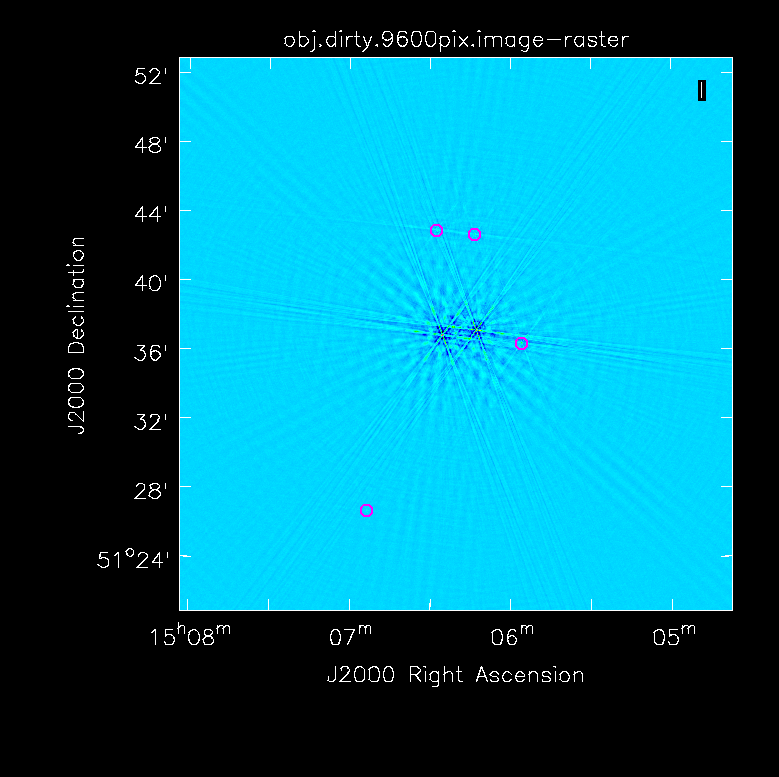 |
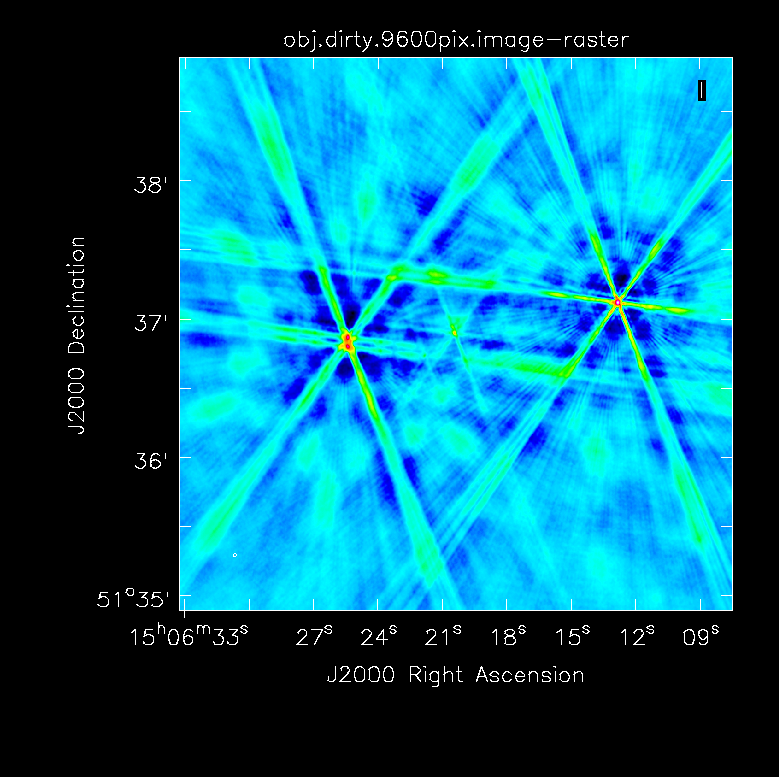 |
Now, we can make a preliminary clean image before rounds of self-calibration to use as a reference.
# in CASA
tclean(vis='obj.ms',imagename='obj.prelim_clean.3am',imsize=750,cell='0.24arcsec',weighting='briggs',deconvolver='mtmfs',niter=1000,interactive=True)
- cell='0.24arcsec': The observations were taken in C-band in configuration B which gives a resolution of 1.2". Thus to 5 elements across the resolution of 1.2", we require a cell size of 0.24"/pixel.
- imsize=750: For the science, we are only interested in the sources within ~1.5' of the cluster center. From the dirty image we also know that there are not any particularly problematic outliers in the field nearby, thus we create a 3' image. Thus to get an image of the entire PB, we use an imsize of 750 pixels.
- deconvolver='mtmfs': Josh:I believe you recommended this to be based on the width of the band of observations with respect to the observing frequency -- I don't remember the qualitative guidelines for center_frequency/total_bandwidth. This corrects for the spectral slope when wideband width -- in this case 1.87GHz.
- niter=1000: Set a relatively large number of iterations as a starting point.
- interactive=True: So we can interactively place the mask.
For this preliminary clean, we place circles around each of the strong sources in turn:
- The rightmost source (Figure 2A) -- continue forward and let it clean by pressing the green circle arrow
- The leftmost double-lobed source (Figure 2B)
- The middle source (Figure 2C)
At this point, there is no more emission that is believably real and we stop cleaning (a total of about 225 iterations)(see Figure 2D for an example of the artifacts that are not believable). The final cleaned image without the help of self-cal (Figure 3) shows a lot of artifacts and demonstrates a need for self-calibration (more details about why need self-cal? or why would think self-cal would help?).
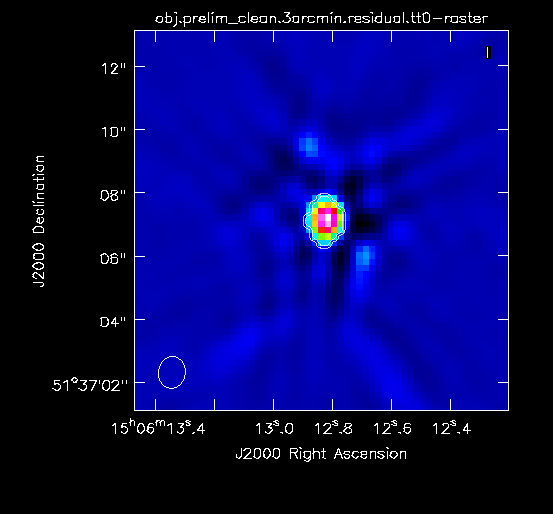 |
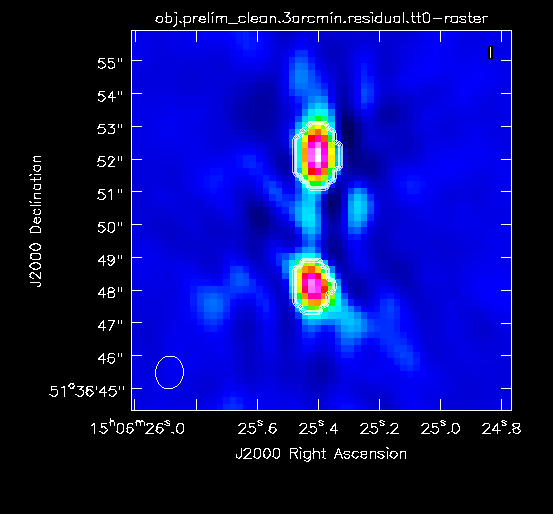 |
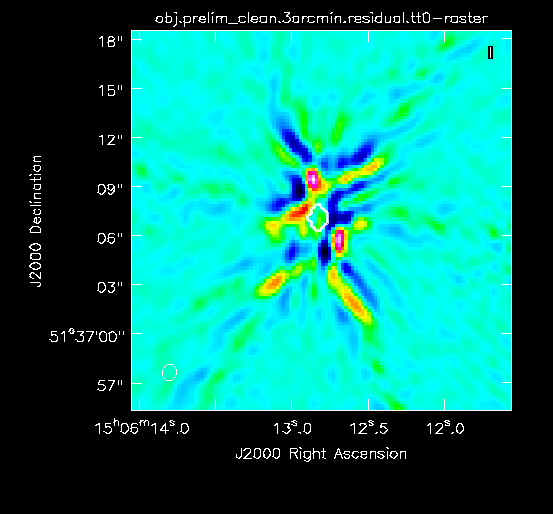 |
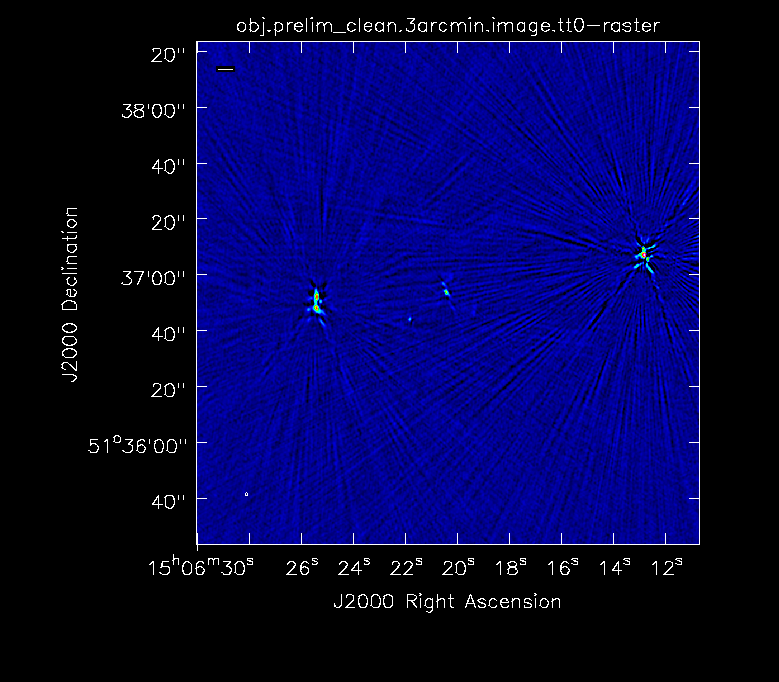
Self-Calibration Process Outline
Each "round" of self-calibration follows a general procedure:
- Conservatively clean target. Using interactive clean, only include the pixels that you are absolutely certain are real emission as this will be the basis of the model for calibration.
- Use gaincal with a particular solution interval to calculate a table of solutions.
- Check the solutions using plotcal.
- Determine if the solutions should be applied (or if it is time to stop). Is there structure to the solutions?
- Use applycal to apply the table of solutions to the data.
- Use split to make the calibrated data with the applied solutions, the new data (the starting point for the next round of self-cal).
- Start the next round of self-cal.
This guide will cover:
- How to do the self-calibration process in general.
- How to determine optimal selfcal parameters (e.g. solution interval).
- When to stop self-cal.
First Round of Self-Calibration
For this first round of self-cal, we will explore various parameters in order to settle on the optimal parameters.